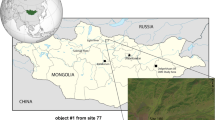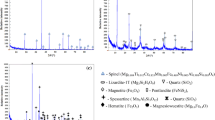Abstract
Crucible steel production at Ghattihosahalli in the nineteenth century has been the subject of detailed study, based both on the contemporary historic record and the physical survival of the mounds of production debris at the village. The published reports have been based on the scientific study of samples collected from the mounds but left questions that could only be resolved by archaeological excavation. Preliminary excavations had already taken place which revealed the remains of a crucible steel smelting installation. Unfortunately the instigator of these investigations, Prof. K.P.N. Rao, died before these could be worked up for publication. This has now been done and the results published here. With the vital information provided by the excavation of the smelting site, it is now possible to give a much more complete description of the operations, not just at Ghattihosahalli, but of the production of crucible steel by the ‘Mysore’ in-situ carburisation process in general.












Similar content being viewed by others
Notes
This seems a remarkably small weight, especially as at the end of the process each crucible now contained 24 rupees, ~ 280 gms of steel! At Ghattihosahalli the typical weight of a steel ingot was 13 oz, 370 g.
References
Anantharamu, T. R., Craddock, P. T., Nagesh Rao, K., Murthy, S. R. N., & Wayman, M. (1999). Crucible steel of Ghattihosahalli, Karnataka. Journal of the Historical Metallurgy Society, 33(1), 13–25.
Anossoff, P. (1841). On the Bulat (in Russian) Gorny Journal, Moscow (Translated into French). Journal des Mines de Russie, 192–236.
Balasubramanium, B. (2007). New insights on classification of iron-carbon alloys specially, high carbon steels. Indian Journal of History of Science, 42(2), 427–444.
Bronson, B. (1986). The making and selling of Wootz: A crucible steel of India. Archeomaterials, 1(1), 13–51.
Buchanan, F. (1999). A Journey from Madras through the Countries of Mysore, Canara and Malabar 23rd April 1800 to 6th July 1801 (3 vols.). London: T. Cadel and W. Davies and Black, Perry and Kingsbury. (Reprinted from 1807, Delhi: Asian Educational Services).
Coomarasawamy, A.K. Medieval Sinhalese Art. New York: Pantheon Books. (Reprinted from the original 1908 publication).
Craddock, P. T. (1998). New light on the production of crucible steel in Asia. Bulletin of the Metals Museum of the Japan Institute of Metals, 29, 41–66.
Craddock, P. T. (2007). Cast iron: The elusive feedstock of crucible steel. Indian Journal of History of Science, 42(2), 593–607.
Craddock, P. T., Andrews, P., & Spataro, M. (2016). ‘Not even if we offered him £ 50’: Early crucible steel production and the history of the Huntsman process. Journal of the Historical Metallurgy Society, 50(1), 28–42.
Feuerbach, A., Merkel, J. F., & Griffiths, D. R. (1997). Production of crucible steel by co-fusion: Archaeometallurgical evidence from the ninth-early tenth century at the site of Merv, Turkmenistan. In P. Vandiver, J. Druzik, J. Merkel, & J. Stewart (Eds.), Materials Issues in Art and Archaeology (Vol. V, pp. 105–110). Warrendale, P. A.: Materials Research Society.
Freestone, I. C., & Tite, M. S. (1986). Refractories in the Ancient and Preindustrial World. In W. D. Kingery (Ed.), High-Technology Ceramics Past, Present and Future. Ceramics and Civilisation, III (pp. 35–64). Westerville, Ohio: American Ceramic Society.
Holland, T.H. (1893). Iron resources and iron industries of the southern districts of Madras Presidency. Imperial Institute Handbook of commercial products No. 8. Calcutta.
Jaikishan, S. (2007). Survey of iron and wootz steel production sites in northern Telangana. Indian Journal of History of Science, 42(2), 445–460.
Jaikishan, S. (2013). New insights on the wootz steel of Telangana. In J. Humphris & T. Rehren (Eds.), The World of Iron (pp. 116–123). London: Archetype.
Juleff, G. (1998). Early Iron and Steel in Sri Lanka, AVA-Materialien, 54. Mainz: Philipp von Zabern.
Juleff, G., Jaikishan, S. and Srinivasan, S. (2014). Northern Telangana, an iron and crucible steel production landscape in India: pioneering metallurgy field Survey 2010. In K. Nagata, E. Izawa and E. Yamasue (Eds.), Proceedings of the BUMA VIII: Cultural Interaction and the Use of Metals (pp. 80–87). Tokyo: Yabuuchi Satoshi.
Krishnan, M. S. (1954). Iron ore, iron and steel. Bulletin of the Geological Survey of India, Series a: Economic Geology, 8, 1–236.
Lowe, T. L., Merk, N., & Thomas, G. (1991). An historical mullite fiber-reinforced ceramic composite: Characterization of the “Wootz” crucible refractory. In P. B. Vandiver, J. Druzik, & G. S. Seagan (Eds.), Materials Issues in Art and Archaeology, II (pp. 627–632). Pittsburgh: Materials Research Society (MRS).
Masalaski. (1841). Preparation of Damascus steel in Persia, (in Russian) Gorny Journal, Moscow, translated into French in Journal des Mines de Russie, 192–297–308.
Mushet, D. (1840). Papers on Iron and Steel. London: Weale.
Rao, K.N.P. (1980). Iron and steel technology in India in ancient and pre-industrial time periods. The Metallurgist and Materials Technologist, 468–70.
Rao, K.N.P. (1987). Scientific investigation on ancient metal working of copper and iron in Karnataka, “Wootz”: Indian Crucible Steel. Unpublished but intended for the annual report of the centre for History and Philosophy of Science. Bangalore: Indian Institute of World Culture.
Rao, K. N. P., Mukherjee, J. K., & Lahiri, A. K. (1970). Some observations of the structure of ancient steel from South India and its mode of production. Bulletin of the Historical Metallurgy Group, 4(1), 12–17.
Rehren, Th., & Papachristou, O. (2000). The Ferghana process of crucible steel smelting. Metalla, 7, 55–69.
Sambasiva Iyer, V.S. (1898–99). Report on prospecting work in parts of the Chitaldroog and Tumkur districts during the field seasons of the years 1896–9. Records of the Mysore Geological Survey II, 102–10.
Sambasiva Iyer, V.S. (1900–01). Notes on the economic mineral products of the Chitaldroog and Shimoga districts. Records of the Mysore Geological Survey, III, 240–46.
Srinivasan, S. (2017). Ultrahigh-carbon wootz from crucible carburization of molten iron: hypereutectoid steel from Tamil Nadu Process at Mel-siruvalur. In A. Giumlia Mair (Ed.), Aspects of Ancient Metallurgy: Materials and Manufacturing Processes, 32(7 & 8).
Srinivasan, S. (2013). Indian iron and steel with special reference to southern India. In J. Humphries & Th. Rehren (Eds.), The World of Iron (pp. 83–90). London: Archetype Publications.
Srinivasan, S., & Griffith, D. (1997). Crucible steel in south India: Preliminary investigations on crucibles from newly identified sites. In P. Vandiver, J. Druzik, J. Merkel, & J. Stewart (Eds.), Material Issues in Art and Archaeology V (pp. 111–125). Warrendale, P. A.: Materials Research Society.
Srinivasan, S., & Ranganathan, S. (2004). India’s Legendary Wootz Steel. Bangalore: National Institute of Advanced Studies and Indian Institute of Science.
Sriperumbudur, J. (2013). New insights on the wootz steel of Telangana. In J. Humphries & Th. Rehren (Eds.), The World of Iron (pp. 116–123). London: Archetype Publications.
Tylecote, R. F. (1962). Metallurgy in Archaeology. London: Arnold.
Tylecote, R. F. (1976). A History of Metallurgy. London: The Metals Society.
Voysey, H. W. (1832). Description of the native manufacture of steel in India. Journal of the Asiatic Society of Bengal, 1, 245–247.
Wayman, M. L., & Juleff, G. (1999). Crucible steel making in Sri Lanka. Journal of the Historical Metallurgy Society, 33(1), 26–42.
Author information
Authors and Affiliations
Corresponding author
Additional information
Publisher’s note
Springer Nature remains neutral with regard to jurisdictional claims in published maps and institutional affiliations.
Rights and permissions
About this article
Cite this article
Rao, K.N., Craddock, P.T. & Anantharamu, T.R. The production of crucible steel by the ‘Mysore process’ at Ghattihosahalli, Chitradurga District, Karnataka. Indian J Hist. Sci. 56, 182–194 (2021). https://doi.org/10.1007/s43539-021-00021-1
Received:
Accepted:
Published:
Issue Date:
DOI: https://doi.org/10.1007/s43539-021-00021-1




